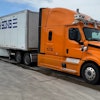
Northrop Grumman said it has been picked by DARPA, the U.S. military's agency for special research projects, to come up with a concept for building a railroad network on the Moon.
The defense contractor's vision for a lunar railroad provides capabilities for transporting people, supplies and resources for commercial entities with operations on the lunar surface – essentially creating a key supply chain component for a future space economy. It could provide logistics for the U.S. as well as international partners.
Most Read on IEN:
- Bernie Sanders Wants U.S. to Adopt 32-Hour Workweek
- Podcast: GM Tattles on Drivers, Weird Chinese EVs, CEO Sells Fake Implants
- Boeing Tells Airlines to Check Pilot Seats After Report That Accidental Shift Led Plane to Plunge
- Gen Z in Manufacturing: A Sustainability-First Generation Looks to Influence 3D Printing
Northrop Grumman said its initial research will focus on defining the interfaces and resources required to build a lunar rail network and establishing a critical list of foreseeable cost, technological and logistical risks. The company said it also plans to develop prototypes for demonstrations and analyses of the design concepts and architecture necessary to build a lunar rail system. Constructing and operating the system -- including foundation work, track placement, finishing and maintenance -- will likely rely heavily on robotics.
“This investment in key developmental research keeps our technology at the forefront of next generation solutions. With our proven experience in the integration of complex systems and commercialized autonomous services, we will continue to create lasting change for a sustainable space ecosystem," said Chris Adams, vice president and general manager of strategic space systems at Northrop Grumman.
The lunar railroad project is part of DARPA’s larger LunA-10 Capability Study, which the agency said was established to help build an analytical framework for integrated lunar infrastructure.
“A large paradigm shift is coming in the next 10 years for the lunar economy,” said Dr. Michael “Orbit” Nayak, program manager in DARPA’s Strategic Technology Office. “To get to a turning point faster, LunA-10 uniquely aims to identify solutions that can enable multi-mission lunar systems – imagine a wireless power station that can also provide comms and navigation in its beam. For 65 years, DARPA has pioneered and de-risked technologies vital to civil space advancement — from the rocket technology in the Saturn V that took humans to the Moon for the first time, to the recent DARPA-NASA partnership to enable faster space travel to the Moon and beyond with a nuclear thermal rocket engine. LunA-10 continues this rich legacy by identifying and accelerating key technologies that may be used by government and the commercial space industry, and ultimately to catalyze economic vibrancy on the Moon.”






















